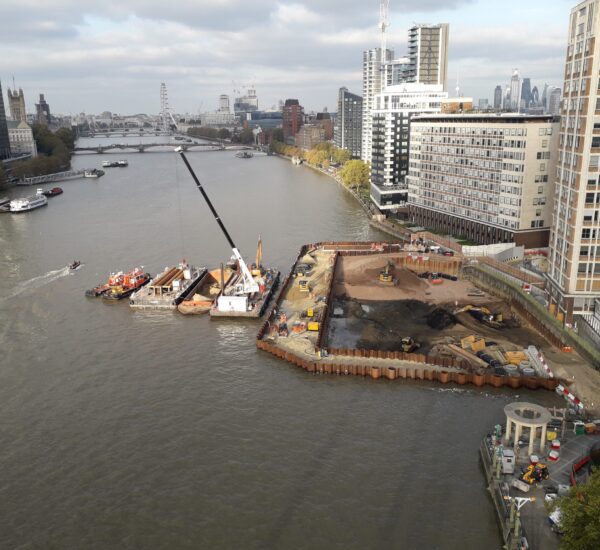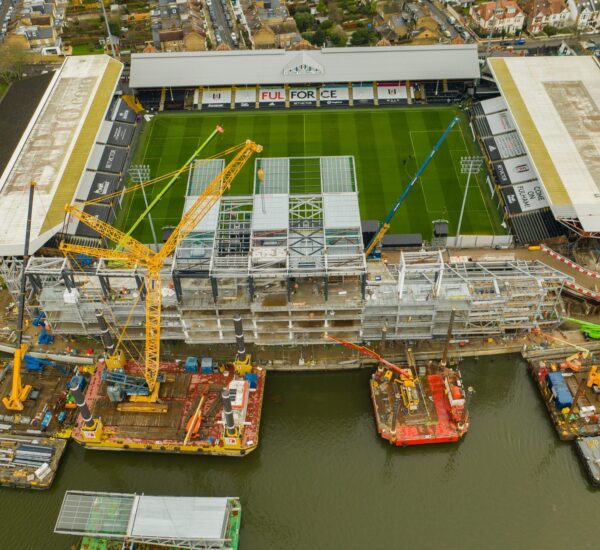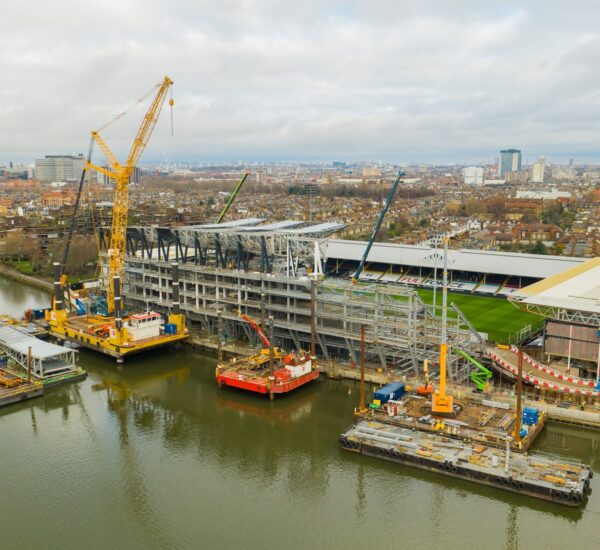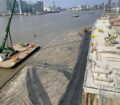Fulham FC New Riverside Stand
Overview
- Client: Buckingham Group
- Project Value: £110m
- Dates: July 19 – March 22
The project works to be undertaken are part of the Fulham Football Club New Riverside Stand Development. The site is located in the London Borough of Hammersmith & Fulham, North of the River Thames, bounded by Bishops Park, Stevenage Road and Stevenage Park.
The Fulham Football Club Riverside stand redevelopment project will add an additional 3,900 seats, taking the capacity of Craven Cottage to a total of 29,600 as well as enhancing local amenities. The new stand will also become a leisure destination, housing shops, restaurants, bars and even a health club with rooftop pool.
In addition, a new riverside walk will be created to be open to the public on non-match days (and limited hours on match days).
Due to the relatively small site footprint and proximity to the River Thames, logistics was a key challenge. We were able to utilise the river to its full capacity for delivery of the project, from off site fabrication and delivery via barges and tugs, to crane barges and Jack Up Barges used for construction, supported by materials barges, marine access systems and transfer craft.
We were employed on the project as the Marine Project Management Team and Marine Contractor. Scope included:
New river wall: combiwall tube (composite steel and concrete) and sheet piles
Marine tubular bearing piles (composite steel and concrete)
Marine deck: precast and in-situ
Steel frame installation
Bulk excavation and muck away via river
Marine furniture and fendering
Marine logistics
Temporary barge berth design and installation
Prefabrication of roof truss sections of site in Port of Tilbury and installation on site using 400T crane located on 600T Jack Up Barge
Marine Plant: 4 no. Jack Up Barges, 3 no. floating crane barges, hopper barges, excavator barges, support vessels
Project Management
We were employed as the Marine Project Management team with overall responsibility for the safe and effective delivery of the marine works on site. This also included the off site load out and fabrication yards in Port of Tilbury, Royal Docks and Greenwich.
Engineering
Stability analysis for the barges
Deck loading analysis for the barges
Planned, supervised, and carried out all lifting operations on site (landside and marine). Most notable being the 55T roof truss sections delivered via barge and lifted using an LR1400 crane located on the 600T Jack Up Barge
Site wide (marine and landside) Temporary Works Coordinators. Completing temporary works designs, inspecting and signing permit to loads and providing support to the project team for implementing solutions to challenges.
Design and installation of temporary excavation load out berth
Site engineering including quality assurance, setting out and surveying, drawings, coordinating works and planning of operations
Marine Logistics
Planned, supervised and carried out mobilisation of all marine plant to site. Including floating crane transfers, assembly of Jack Up Barges.
Passage plans for challenging tows, most notably the roof truss sections that were delivered with a 7.1m air draft. Departing from Port of Tilbury, we had to navigate under every bridge through London up to Fulham. For a load this tall it was a significant challenge that took detailed planning and thorough assessment.
Delivery of material barges, planned around the tides to ensure site was always stocked with material for the works.
Utilised the following key sites for supporting the project:
Port of Tilbury
Royal Docks, London
Thamescraft Dry Docking, Greenwich
Planning bulk excavation operations around the tides for loading hopper barges and towing to disposal site
Construction
New river wall: combiwall tube (composite steel and concrete) and sheet piles
Marine tubular bearing piles (composite steel and concrete)
Marine deck: precast and in-situ
Steel frame installation
Bulk excavation and muck away via river
Marine furniture and fendering












